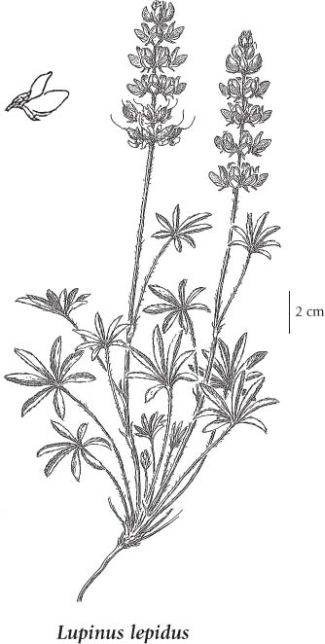Lupinus lepidus Douglas ex Lindl.
prairie lupine (Pacific lupine)
Fabaceae (Pea family)
Introduction to Vascular Plants
prairie lupine (Pacific lupine)
Fabaceae (Pea family)
Introduction to Vascular Plants
A red-listed taxon in BC
Species Information click to expand contents
General:
Perennial herb from a woody stem-base; stems several, slender, tufted, decumbent to erect, 20-45 cm tall, silky and with some longer ascending hairs.
Leaves:
Mostly basal with stalks 10-16 cm long, a few alternate along the stem, palmately compound; leaflets 6 to 10, oblanceolate, pointed at the tip, 1-5 cm long, 2-7 mm wide, mostly folded, silky on both surfaces.
Flowers:
Inflorescence a terminal raceme, about as long as its stalk, of whorled pea-like flowers; corollas blue, white or lavender, 10-13 mm long, the banner egg-shaped to nearly circular, glabrous, the wings glabrous, rather narrow, the keel fringed with hairs along the upper edges; calyces 2-lipped, the upper lip 2-toothed, cleft for at least 1/2 its length, both lips 5-7 mm long.
Fruits:
Pods, 1-3 cm long, stiff-hairy; seeds 2 to 4.
Illustration click to expand contents

If more than one illustration is available for a species (e.g., separate illustrations were provided for two subspecies) then links to the separate images will be provided below. Note that individual subspecies or varietal illustrations are not always available.
Illustration Source: The Illustrated Flora of British Columbia
USDA Species Characteristics click to expand contents
Flower Colour:
Blue
Blooming Period:
Early Summer
Fruit/Seed characteristics:
Colour: Brown
Present from Spring to Fall
Source: The USDA
Ecology click to expand contents
Ecological Framework for Lupinus lepidus
The table below shows the species-specific information calculated from
original data (BEC database) provided by the BC Ministry of Forests and Range.
(Updated August, 2013)
The table below shows the species-specific information calculated from
original data (BEC database) provided by the BC Ministry of Forests and Range.
(Updated August, 2013)
| Site Information |
Value / Class |
||
|
Avg |
Min |
Max |
|
| Elevation
(metres) |
2186 | 1875 | 2470 |
| Slope
Gradient (%) |
22 | 0 | 55 |
|
Aspect (degrees) |
245 | 23 | 360 |
| Soil
Moisture Regime (SMR) [0 - very xeric; 4 - mesic; 8 - hydric] |
1 | 1 | 4 |
| Modal
Nutrient Regime
Class |
B | ||
| #
of field plots species was recorded in: |
8 | ||
| Modal
BEC Zone Class |
IMA | ||
|
All BEC Zones (# of stations/zone) species was recorded in |
ESSF(3), IMA(3) | ||
|
Source:
Klinkenberg 2013
|
|||
Habitat and Range click to expand contents
Dry gravelly openings and rock outcrops in the lowland zone; rare on SE Vancouver Island; S to NW OR.
Status Information click to expand contents
| Origin Status | Provincial Status | BC List (Red Blue List) | COSEWIC |
|---|---|---|---|
| Native | S1 | Red | E (Apr 2009) |
BC Ministry of Environment: BC Species and Ecosystems Explorer.
Synonyms click to expand contents
Synonyms and Alternate Names:
Lupinus aridus var. cusickii (S. Watson) C.P. Sm.
Lupinus lepidus subsp. aridus (Douglas) Detling
Lupinus lepidus subsp. cusickii (S. Watson) Detling
Lupinus lepidus var. aridus (Douglas) Jeps.
Lupinus lepidus var. cusickii (S. Watson) C.L. Hitchc.
Lupinus lepidus var. lepidus
Lupinus longivallis C.P. Sm.
Similar Species click to expand contents
In B.C., Lupinus minimus has been included in Lupinus lepidus but is now recognized as a separate species and can be distinguished by its range, which includes the Columbia River drainage and Alberta. In B.C., Lupinus lyallii, Lupinus kuschei, and Lupinus wyethii are all similar to Lupinus lepidus var. lepidus in that they are less than 50 cm tall and have blue flowers and densely hairy leaves. Only L. lepidus var. lepidus is found in coastal lowlands on southeastern Vancouver Island. L. lyallii occurs in subalpine/alpine areas in the Coastal and Cascade mountains. L. kuschei is a montane species found in northern B.C. L. wyethii occurs in the steppe/montane zones of southern B.C.
Source: British Columbia Conservation Data Centre |